The AMD Llano Notebook Review: Competing in the Mobile Market
by Jarred Walton & Anand Lal Shimpi on June 14, 2011 12:01 AM ESTPower Gating
With 1.45 billion transistors on die, Llano relies on extensive power gating in order to keep things in order. The APU is split into two independent power islands: the CPU and the GPU. The memory controller and North Bridge both live on the GPU's power island. Each island has its own independent voltage source.
Everything from an individual CPU core to the entire GPU or virtually the entire APU package can be power gated. AMD provided photon recombination images to show the impact power gating the GPU can have on leakage current:
Although not depicted above, Llano can also fully power gate the x86 CPU cores or both the CPU and GPU if the entire APU is in a deep sleep state. Being able to completely power gate CPU cores or the GPU is an important part of enabling the next major feature of Llano: Turbo Core.
Turbo Core
All processors whether CPUs, GPUs or APUs have to be designed to strict thermal and power limits. OEMs need to know exactly what sort of chassis they'll be able to build around these chips and as a result the chip vendors provide guidance in the form of specifications, including the chip's thermal design point (TDP).
In the old days of microprocessors things were simple. You had a single core that ran all the time and it consumed all of the available thermal budget allocated for that core. AMD and Intel eventually enabled dynamic clock frequencies which let your single core underclock itself when it wasn't being used, which helped reduce power and extend battery life. Then came the multi-core era.
CPUs couldn't just start putting out twice as much heat now that they had two cores; instead, each core had to consume less power. The chip guys achieved this by running the cores at lower frequencies and voltages than they did in the single-core days. Two cores paved the way to four cores, which meant another reduction in clock speed per core. Sure we got much better multi-threaded performance, but for single-threaded applications performance wasn't as great as it could be. Users had to make a tradeoff: good multi-threaded performance or good single-threaded performance; you couldn't have both. Until power gating came along that is.
Without power gating you can never really shut off power to an idle core. The transistors aren't switching but power is still dissipated thanks to leakage current. Remember that transistors don't simply stop conducting electricity when they're off. The smaller they get, the more leaky our beloved transistors become. Power gating lets you physically block the flow of current to the transistors that are being gated, so when they're off, they're actually off. With an idle core shut off, now you have the extra TDP headroom to run any active cores at higher frequencies.
Intel does this with a technology it calls Turbo Boost. Intel looks at current draw and thermal sensors spread out all over the chip and determines when it has the available thermal headroom to turbo up any active cores. AMD implements a similar technology in Llano (and previously in their hex-core desktop parts) called Turbo Core.
I say similar but not identical because AMD's approach differs in a very important way. While Intel looks at current draw and temperature data, AMD looks at workload. Each activity within the Llano APU is assigned a certain power weight (e.g. an integer multiply is known to require a certain amount of power). Llano is aware of the operations it's currently working on and based on the weights associated with these operations it comes up with a general estimate of its power consumption on a per core basis. I mention this is an estimate because it correlates digital activity to power consumption; it doesn't actually measure power consumption.
Based on the number of events and their individual weights, AMD estimates the power consumption of each core and determines how much TDP headroom exists in the system. If the OS is requesting the highest p-state from the CPU and there's available TDP headroom, Llano will turbo up any active cores up to a maximum frequency. Like Sandy Bridge, Llano is able to temporarily exceed the APU's maximum TDP if it determines that the recent history of power consumption has been low enough that it'll take a while for the APU to ramp up to any thermal limits.
One major limit of Llano's Turbo Core is that the GPU can't turbo up in the event of the CPU cores being idle. Only the CPU cores can turbo up if they have available headroom. I suspect future versions of Llano will probably enable GPU Turbo Core as well:
It's unclear to me at this point what shortcomings or advantages exist for AMD's Turbo Core method vs. Intel's Turbo Boost. At the bare minimum the two are finally comparable although they use different approaches to attain a similar end result. AMD doesn't yet have a method of actually displaying Turbo Core frequencies, unfortunately, so we're operating a bit blind at this point. Over time I hope to have a better idea of how AMD's solution stacks up.


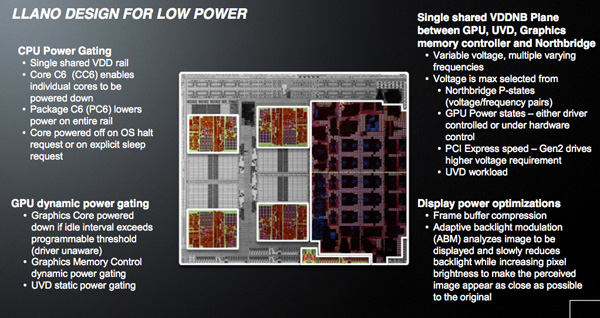
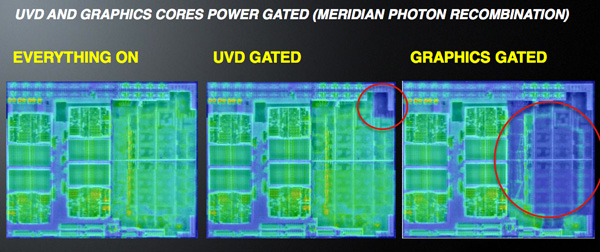
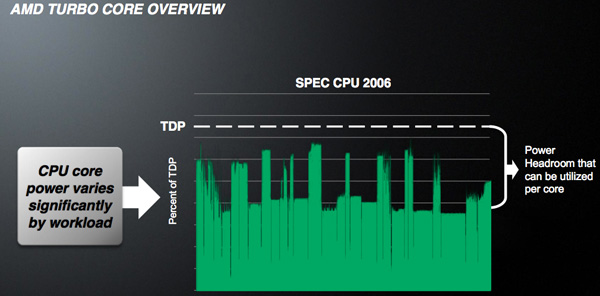
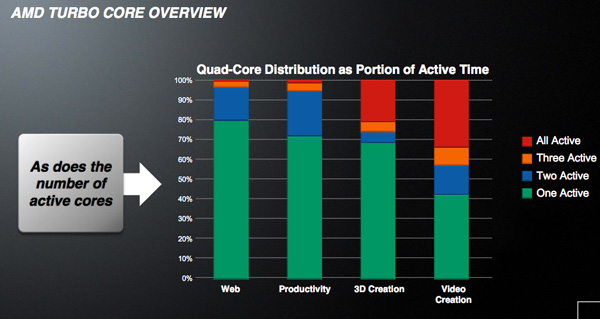
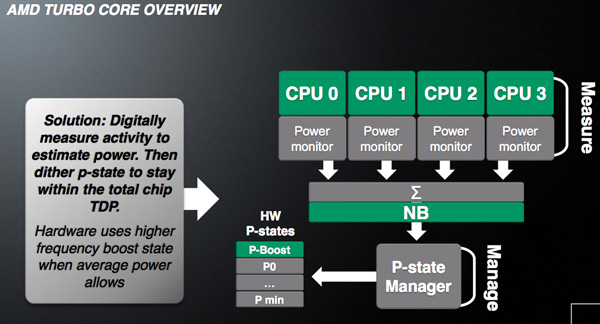
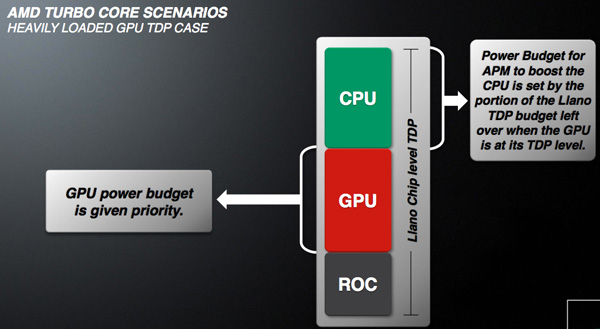
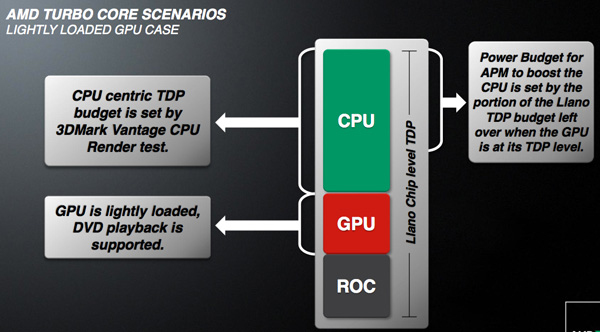








177 Comments
View All Comments
JarredWalton - Tuesday, June 14, 2011 - link
Civ5 and TWS2 are both tested with the latest drivers. The K53E was also tested with drivers that are at most a couple months old. Intel current lists the latest laptop drivers as 15.22.1.64.2361 from 4/13/2011, which is what I'm running on the Intel units right now. If there are some newer drivers that I'm missing out on, let me know and I'll go try them.duploxxx - Tuesday, June 14, 2011 - link
Nice review, it seems like there is a lot of work on CF.Actually I reviewed the Liano already months ago, I mentioned in the last mobile reviews that it will be better performing then the Toshiba with the P920 with really good battery performance. So it is a win -win for the budget line anyhow. Top line remains intel for the CPU power.
Regarding the quote:
Now if you want to have your cake and eat it too, the APU to wait for would be Trinity. Due out somewhere in the 2012 - 2013 timeframe, combine a Bulldozer derived architecture with AMD's next-generation GPU architecture and you've got Trinity.
Trinity will not only be an improved GPU it also has the BD core inthere which will offer much more punch. THe reason LIano is late is because of the 32NM process. It could have been released much sooner. Sure they took an outdated K10 and that is the main issue together with the not enough aggressive Turbo for single thread, they should have adapted this more aka BD.
But assumin Trinity is a rather late 2012 project (by stating 2012-2013) you are way way off...
ET - Tuesday, June 14, 2011 - link
Quote probably reflects an increase in pessimism due to recent events. Bulldozer is still not out, and AMD is said to have had a hard time getting clocks up. So sure, we're all hoping to see Trinity early in 2012, but anyone setting their expectations a little farther are less likely to be disappointed.duploxxx - Wednesday, June 15, 2011 - link
didn't i mentioned it would be launch faster then expected?http://www.cpuforever.com/showthread.php?tid=1574&...
the delay of Zambezi BD has nothing to do with real architecture issues.....
ET - Wednesday, June 15, 2011 - link
That's not the sites which posted on it, including Anandtech, said based on what AMD said (that is, that Bulldozer was not up to speed).Jamahl - Tuesday, June 14, 2011 - link
Was that really needed? I mean...really? Who the hell would do that and for what reason?ET - Tuesday, June 14, 2011 - link
I already got my E-350 laptop, but as Jarred says, Brazos just became less interesting. I'll be waiting to see what price point and performance the dual core Llano will have. What impressed me most was battery life, which is competitive with the E-350 laptop, and it'd be interesting to see how small and light Llano laptops will get.The other takeaway I have from this is that as usual I'm impressed at how far Intel has gone with its integrated graphics. Sure Llano gives it a good beating, but that's at the expense of a lot more die space. I imagine that Intel will continue to tweak its 3D cores and I can't wait to see how this race will develop.
Anosh - Tuesday, June 14, 2011 - link
What happened to power consumption?!Some of us get laptops due to the optimization in the power department over similar desktop parts!
JarredWalton - Tuesday, June 14, 2011 - link
Power = [Battery Capacity] / .98 [efficiency] / ([Battery life in minutes] / 60)So if you take the battery life charts, you can determine roughly what the total system power draw is using the above. Or you can look at the "Relative Battery Life" charts and get the same information as Minutes/Wh instead of converting into Watts.
jabber - Tuesday, June 14, 2011 - link
In my work I get a lot of laptops to fix. If there is one game or genre that appears on 80% or more of them its......The Sims.
I also get asked a lot "if I buy this laptop will it play The Sims?"
Never ever been asked if a laptop will play Crysis or any of the games you use.
Just saying.